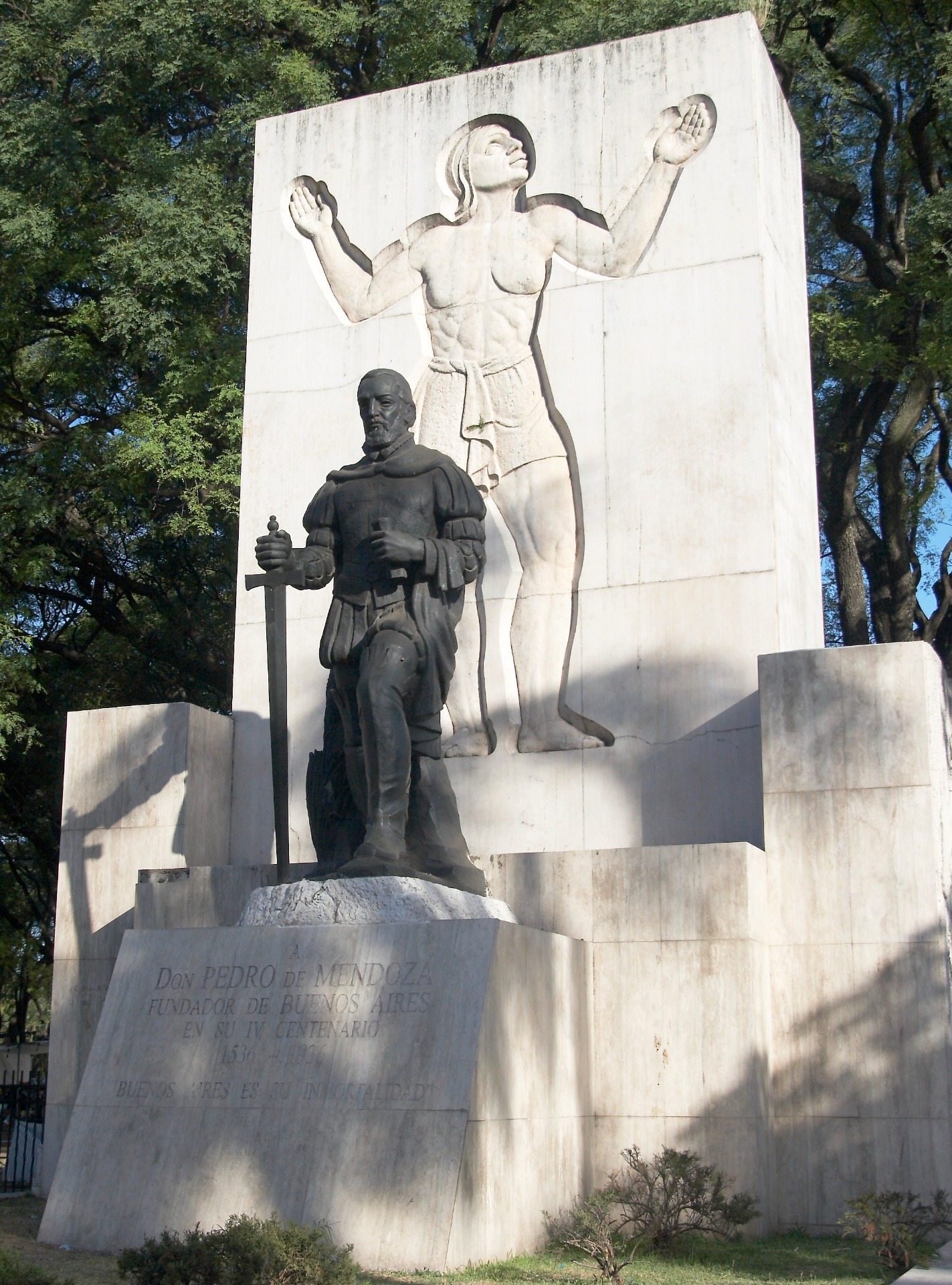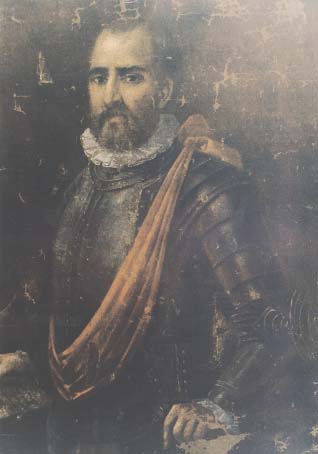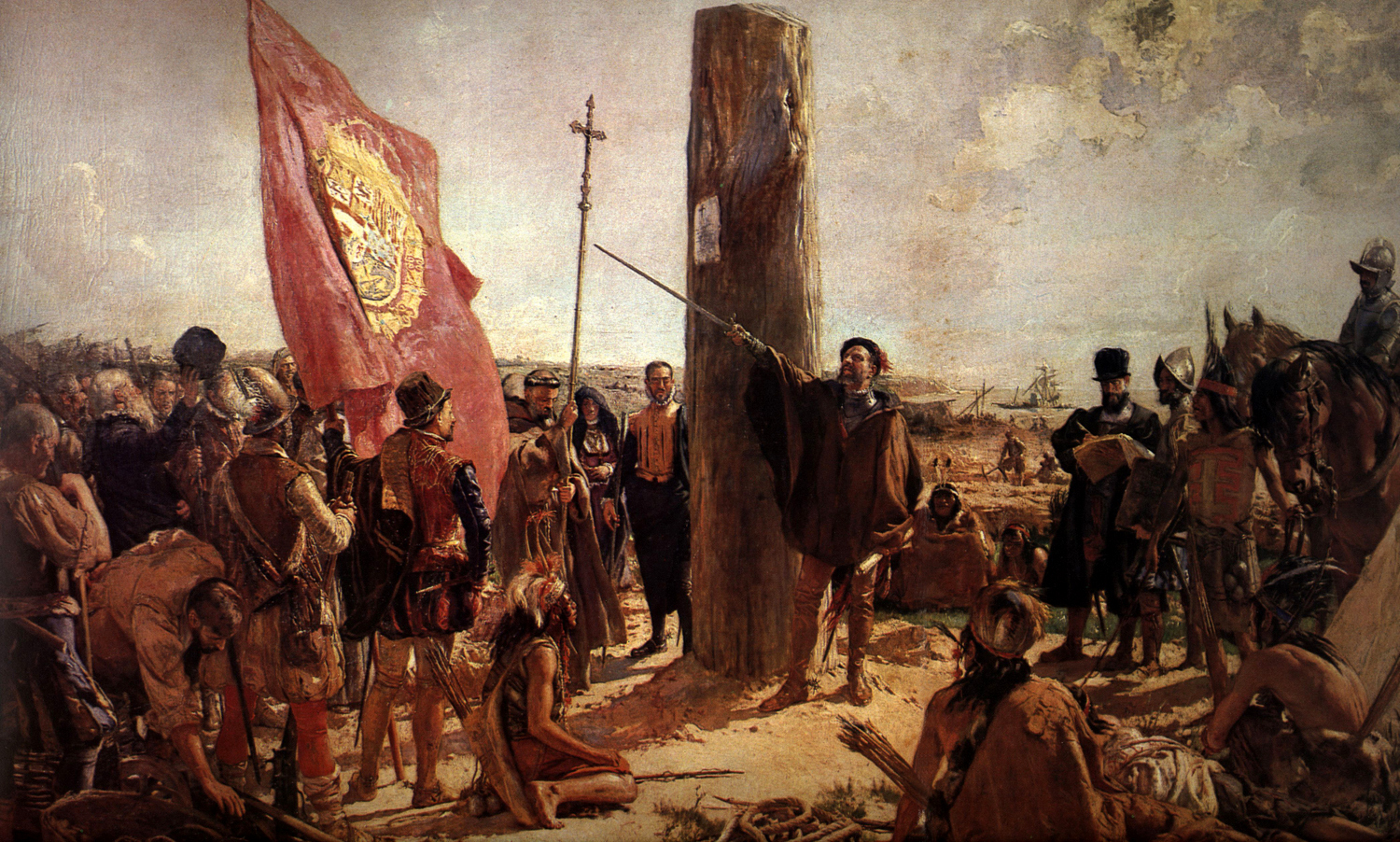
Foundation of Buenos Aires in 1580
Buenos Aires had two foundations, the first in 1536 by the Spanish conqueror Pedro de Mendoza (1487-1537), but destroyed in 1541 by the Indians, who also killed all it's inhabitants, and then the second and last foundation, carried out in 1580 by the Spanish explorer, Juan de Garay (1528-1583), who did not cross the Atlantic Ocean to do so, but came down from Asunción del Paraguay, where he had lived for more than twenty years. On both occasions the discovered territory belonged to the Viceroyalty of Peru of the Spanish Empire.
The first expedition to reach the Río de la Plata was that of the Spanish navigator Juan Díaz de Solís (1470-1516) in January 1516, who landed on the coasts of Uruguay and after this installation, Solís was attacked and killed by the Indians of the region. Four years later, the fleet of the Portuguese explorer Hernando de Magallanes (1480-1521) crossed the coast of the province of Buenos Aires and discovered the Strait of Todos los Santos on October 21, 1520. But recently, in June 1527, Sebastián Caboto (1477-1557), entered the Paraná River and founded Fort Sancti Spiritus; then he returned to Spain in 1530, taking with him the legend of "La Sierra de Plata y las tierras del Rey Blanco".
This legend was the one that induced Carlos I of Spain (1500-1558) to finance Pedro de Mendoza's expedition abroad in 1536.
Pedro de Mendoza suffered from syphilis, and due to the worsening of his illness, he left the expedition in the hands of Irala and returned to Spain in April 1537, dying on the trip. The inhabitants of the old Fort were finally transferred to Asunción in 1541 and the destruction of the fortress was ordered.
Since the failed attempt by Pedro de Mendoza, who did not live more than four or five years (between 1536 and 1541), the Spanish Crown would take forty years to complete the much-needed repopulation of Buenos Aires.
The second and definitive foundation, carried out by Juan de Garay, was on June 15, 1580, and the recruitment of volunteers for the refounding of Buenos Aires was announced in Asunción del Paraguay (founded in 1537) and in Santa Fe (dated from 1573 ).
To attract settlers, Juan de Garay offered all kinds of benefits: land grants, indigenous plots, and use of existing equine livestock to those who "on their own" were going to populate the River Plate port with their families, livestock, weapons, and farming tools. Given the known lack of agricultural tribes to ensure their livelihood, Garay recognized - in concrete terms - only the ownership of show horses, the only real economic possibility, although evidently precarious.
It's often said that 65 people founded Buenos Aires but there is an error in that, which is to consider only those who, according to the Crown, were people with all rights. The contingent that left Asunción on March 5 made the journey with more than two hundred people, to which we must add those who joined or deserted on the way. After passing through Santa Fe, those 65 individuals "owners" and their companions reached the banks of the Río de la Plata.
Foundation of Buenos Aires in 1580
Picture of the founding of Buenos Aires in 1580, made by José Moreno Carbonero (1858-1942). The reason chosen by the Malaga painter was the founding act, carried out by Juan de Garay with his 63 soldiers, on June 11, 1580, taking possession of the place on behalf of King Felipe II of Spain (1527-1598).
José Moreno Carbonero had proposed that the painting combine three symbols: Religion - Justice - Conquest.
The first of them was represented by the Cross carried by the Franciscan friar P. Rivadeneyra. Justice was symbolized by "el Rollo" or tree stump, where criminals were executed in the public squares of the cities. And the sharp, drawn, raised sword of the king's mighty vassal represented conquest.

The painting by José Moreno Carbonero refers historically to the 'second founding act' of that city on the Río de la Plata, since the first took place on February 2, 1536 by Pedro de Mendoza (sick with syphilis and traveling accompanied by his lover María Dávila), appointed head of the overseas expedition ordered by Emperor Carlos I of Spain.
At the beginning of the seventeenth century, the royal established by Juan de Garay twenty years earlier in the vicinity of the Riachuelo had changed its character from a temporary and military camp that gave it the foundation of huts and leather tents, for a village appearance whose rooms of Raw adobe, alternating with mud and straw huts, was built inside or on the flanks of the lots covered with plants, prickly pears and shrubs. The first carts passed through the wide and muddy streets; but despite its miserable appearance, Buenos Aires was a social embryo that forged its life in a rudimentary environment and without stimuli.
Needs led to initiatives, and given the decision to live that animated the city from its origins, authorizations were negotiated for the chartering of vessels that would bring the fruits of the incipient labor force from the town to the metropolis and import supplies and necessary items from that city. Buenos Aires was a port, and by sea civilization and wealth had to reach it in exchange for the values dispersed in its campaigns and the products of its primitive industries. But this aspiration encountered the obstacle of a prohibitionism that would have kept the nascent city in misery, if some concessions and many violations had not been in charge of initiating and maintaining an exchange on which the existence of the population depended.
BUENOS AIRES & IT'S FIRST INHABITANTS
In the last decade of the 16th century, there was a Lusitanian migratory trend that was accentuated at the beginning of the following century. Added to the prospects of creating a commercial traffic were reasons of personal security on the part of many Portuguese Jews who joined the Hispanic colonial nucleus.
The first inhabitants of Buenos Aires were the founding neighbors who accompanied Pedro de Mendoza (1487-1537) in the first foundation of Buenos Aires in 1536, until its abandonment in 1541, and then Juan de Garay (1528-1583) in his second foundation in 1580, but this time as a city, and that later they settled in it or only at the beginning, adding other newcomers from different parts of the Spanish Empire who would settle in the incipient city and leave extensive descendants.
In 1606, the Buenos Aires Cabildo did not hesitate to interpose its influence with the governor Hernandarias de Saavedra to obtain the repeal of an order for the alienation of numerous Portuguese; and this postulation, submitted to the report of the Franciscan friar Martín Ignacio de Loyola, was resolved favorably, that is, in opposition to the royal ordinances.
It was under these circumstances that the Portuguese Melchor Maciel del Águila, founder of his lineage in the Río de la Plata, arrived in Buenos Aires in 1604.
Melchor Maciel del Aguila / 1583-1633
Melchor Maciel del Águila born as Melchor Fernandes Maciel (Viana do Castelo, Kingdom of Portugal, 1583 - Buenos Aires, Río de la Plata Government, 1633) was a rich landowner and merchant of Portuguese origin who during the dynastic union of his country with the Spanish crown was one of the first settlers of the city of Buenos Aires.
Biography
He was born in 1583 in Vianna do Castello, a city on the north coast of the Kingdom of Portugal, at whose foot the ocean reaches the mouth of Lima and which received its name from the old castle of Sao Thiago; cradle of hardworking sailors from where many Portuguese came from who settled in the territory of the Viceroyalty of Río de la Plata.
Certainly, the possibilities of the birthplace were slim for Melchor Maciel, a man of confidence in himself. He had the sea before his audacity, and he learned from the sailors returning to the port from distant lands that in two months of travel a new world was coming to life. He marched towards him without hesitation, before he was twenty; he arrived in Brazil, and after a stay we do not know about, he embarked as skipper on the caravel San Benito and arrived in Buenos Aires in 1604, loading his own merchandise worth 8,907 silver reales, an appreciable sum at that time.
He was the son of Antón Fernandes (c. 1558) and of the Portuguese infanzona María Díaz de Maciel (b. Viana do Castelo, c. 1563), and in accordance with the custom of his time, he adopted the surname of his maternal grandfather by virtue of of his nobility.
Trip to the Luso-Spanish South American
Towards the year 1598, before reaching the age of twenty, he passed to the General Government of Brazil and later from there as patron of the caravel San Benito went to the government of the Río de la Plata with his own merchandise worth 8,907 silver reales, to become in 1604 one of the first settlers of Buenos Aires.
Since his arrival in this city he dedicated himself to multiple commercial activities, in 1606 he bought the average arroba for 26 pesos at a public auction and since 1608, he obtained from the Cabildo of Buenos Aires the first permit to hunt. He continued to travel to Brazil to carry out various commercial exchanges, thus consolidating himself as a responsible person with experience in various sectors. He also traveled along the Argentine coast to the city of Asunción.
Farmer and landowner of Buenos Aires
Later he dedicated himself to the acquisition of land and livestock activities. In 1617 he bought from Mateo de Monserrate half of his stay in the Pago de Magdalena, 1,500 meters wide by a league and a half deep, which was located south of the Riachuelo. Over time, he acquired more land in the area and also in the Pago de Matanzas, to dedicate himself to agriculture and grazing, which is why he became one of the main ranchers and landowners.
He also traveled to the city of Santa Fe to trade his own cattle, and in 1617 the governor Hernando Arias de Saavedra (1561-1634) commissioned him to bring bighorn cattle, which were the first to be introduced in the Banda Oriental.
Death
Finally, the rich landowner Melchor Maciel del Águila fell seriously ill in the autumn of 1633 and died that same year, assisted by the medical graduate Paulo Francisco; and anticipating his next end, he made provisions about his family and his assets.
His widow Catalina Cabral de Melo joined in 1635, in a second marriage in Buenos Aires, with his son's father-in-law, Pedro Homem de Pessoa y Pereda, mayor of Buenos Aires, and with whom he would have at least three more children.
Marriage & Offspring
The rich merchant and landowner Melchor Maciel del Águila married Catalina de Melo on August 5, 1618, at the age of thirty-five, the age at which the acquisition of real estate and a sedentary lifestyle stabilized his existence.
Maciel had a strong sentimental bond with his country, since the chosen wife was of Portuguese origin, without it being possible to confirm whether she saw the light in Buenos Aires shortly after the arrival of her parents or if she came with them at a very young age. They were Gil González de Moura and Doña Inés Núñez Cabral, whose settlement in the River Plate territory dates from the last years of the 16th century, probably 1599. Inés Núñez Cabral was the sister of Mrs. Margarita Cabral de Melo, wife of field teacher Amador Báez de Alpoin, according to the latter's testamentary statement.
In 1674, Captain Francisco Maciel del Águila stated in a document that his maternal grandfather Gil González "came as a resident of the kingdoms of Spain", and in the 1664 registry, under inscription No. 134, he was awarded the title of general by one of his descendants.
As a result of the bond between Melchor Maciel del Águila and Catalina Cabral de Melo y Moura, there were at least six children:
- María Cabral Maciel del Aguila married Antonio Moyano y Cifuentes de Medina, a native of Santiago de Chile and a neighbor of Mendoza, where he had married Elena Jofré de Arce for the first time. From his second union, Moyano had, among other children, Melchor Moyano Cornejo and Maciel del Águila, who was an encomendero in San Juan, married María de Oscáriz and Beaumont de Navarra in Córdoba, and then in San Juan with Margarita Jofré de Arce ; he testified in that last city, before Ramírez de Arellano, on November 28, 1722.
- Isabel Maciel de Melo, who received oil and chrism on the same date as her sister María, and who had been baptized for the same reason as the previous one, at her home, by Fray Alonso Martínez, a Dominican. It can be presumed that Isabel Maciel died in childhood since it is not mentioned in her father's will.
- Juana Maciel del Águila Cabral de Melo, who married Captain Pedro Bartolomé Homem de Pessoa Figueroa (Santiago de Chile - Buenos Aires, after May 8, 1703), son of the aforementioned nobleman Pedro Homem de Pessoa y Pereda and his first wife Isabel de Figueroa Mendoza y Garcés de Bobadilla (Santiago de Chile, c. 1595 - f. Before 1634), as well as maternal grandson of General Francisco de Figueroa y Mendoza and his wife Juana Garcés de Bobadilla, and paternal great-grandson of Juan de Figueroa y Villalobos (b. Cáceres, 1523), who went to Chile in 1543 and where he was commissioned from Valdivia and Osorno, and from his wife Inés de Mendoza y Carvajal.
- Jerónima de Melo, who was baptized on October 9, 1923. She moved to Santa Fe with her family and there she shook hands with Cosme Damian Dávila, a resident of that city and its councilor in 1641.
- Francisco Maciel del Águila (n. Ib., October 20, 1625) who was baptized on October 29 in Buenos Aires and later associated with Juana Felice de Velasco and had at least Francisco Maciel del Águila "el Mozo".
- Luis Maciel del Águila (ib., 1627 - ib., 1710) was an agricultural rancher who was elected ordinary mayor of the city of Buenos Aires from January 1687 to January 1688, the year in which he was appointed by the owner José de Herrera y Sotomayor as interim deputy governor of Buenos Aires, a position he would hold until around 1695.
Many descendants of Francisco Maciel del Águila "el Mozo" were people of renown or who married ranchers and landowners. One of them was Isabel Llames (c.1845), from a Spanish noble family and the daughter of two cousins, Manuela Saturnina Llames (1824) and the Spanish attorney José Manuel Llames y Roldán (c.1815), who had a natural son with Enrique Foster (1842-1916), colonizer and surveyor, founder of Monte Oscuridad and co-founder of the city of Resistencia, Province of Chaco, Argentina.
The paternal grandparents of Isabel Llames were originally from the Parish of Santiago de Goviendes, Colunga Town Hall, Bishopric of Oviedo, in the Principality of Asturias and according to her great-grandfather regarding their children they were "old Christians, of clean blood and known by origin, not descendants of Jews, Moors, heretics, or recent converts to our Santa Fe, nor who have been convicted of any crime, by Judge or Court, neither Ecclesiastical nor Secular, never investigated by the Holy Inquisition, but rather they have been hidalgos Without ever having exercised jobs opposed to the Nobility and for such noblemen we find ourselves and our elders are listed in the Registers made on Hita Street with this Council of the Noble and Pec State ... (illegible) ".
King Carlos IV of Spain (1748-1819) endorsed the Testimony of Nobility by the Chancellery of Valladolid, indicating that they belong to the family settled in Colunga since time immemorial.
Note
In the sleepy and mean environment of the first half century of Buenos Aires, Melchor Maciel del Águila was an active and dynamic expression, a human motor in movement and the animator of a vital transit that, when carrying out an exchange prohibited by the kings, was tolerated by the governors, admitted by the councils and favored by the population when verifying their profitable results.
Due to his multiple activities, exercised outside of official influences, Melchor Maciel stands out as one of the central figures of that movement that saved Buenos Aires from stagnation and misery. After three centuries of anonymity, his name comes to the fore in the civilizing process of the time, until the sole enunciation of his work and energetic interventions.





